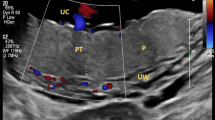Abstract
Background Information
Placenta is the connecting organ between the mother and the fetus. It supplies oxygen and all the necessary elements for the growth and development of the fetus. In normal pregnancy, the growth of the placenta remains concordant with the growth of the fetus. The sonographic assessment of placenta can give information about the nutritional status of the fetus. It is known that normal placental thickness approximately equals gestational age. It is historically documented that placental weight is one-fifth of the fetal weight and abnormally thin or thick placenta is associated with increased incidence of perinatal morbidity and mortality. However, there are very few studies correlating placental thickness with Neonatal outcome.
Objectives
To correlate ultrasonographic placental thickness at 32 and 36 weeks pregnancy with neonatal outcome. To propose placental thickness as a simple test for prediction of neonatal outcome.
Methods
Placental thickness at 32 and 36 weeks was measured by ultrasound, in 130 pregnant mothers with confirmed dates and uncomplicated singleton pregnancy. Placental thickness was categorized as normal (10th–95th percentile), thin (<10th percentile) and thick (>95th percentile) at each stage and was correlated with birth weight and neonatal outcome.
Results
Neonatal outcome was good in women with normal placental thickness (10th–95th percentile) at 32 and 36 weeks and was compromised in women with thin (<10th percentile) and thick (>95th percentile) placentae.
Conclusion
Placental thickness at 32 and 36 weeks corresponds well with gestational age and is a good prognostic factor in assessing neonatal outcome. Therefore, placental thickness should be measured in addition to biometric parameters in antenatal women undergoing ultrasound.




Similar content being viewed by others
Abbreviations
- VMMC:
-
Vardhman Mahavir Medical College
- BMI:
-
Body mass index
- LSCS:
-
Lower segment cesarean section
- NICU:
-
Neonatal intensive care unit
- PC-PNDT Act:
-
Pre-conception and Prenatal Diagnostic Techniques Act
- mm:
-
Millimeter
- CNS:
-
Central nervous system
- ANC:
-
Antenatal clinic
- ITP:
-
Immune thrombocytopenic purpura
References
Schwartz N, Wang E, Parry S. Two-dimensional sonographic placental measurements in the prediction of small for gestational age infants. Ultrasound Obstet Gynaecol. 2012;40(6):674–9.
Ohagwu CC, Abu PO, Effiong B. Placental thickness: a sonographic indicator of gestational age in normal singleton pregnancies in Nigerian women. Internet J Med Update. 2009;4(2):9–14.
Afrakhteh M, Moein A, Their MS, et al. Correlation between placental thickness in the second and third trimester and fetal weight. Rev Bras Ginecol Obstet. 2013;35(7):317–22.
Lee AJ, Bethune M, Hiscock RJ. Placental thickness in second trimester: a pilot study to determine the normal range. J Ultrasound Med. 2012;31(2):213–8.
Agwuna KK, Eze CU, Ukoha PO, Umeh UA. Relationship between sonographic placental thickness and gestational age in normal singleton fetuses in Enugu, Southeast Nigeria. Ann Med Health Sci Res. 2016;6(6):335–40.
Balakrishnan M, Virudachalam T. Placental thickness: a sonographic parameter for estimation of gestational age. Int J Reprod Contracept Obstet Gynaecol. 2016;5(12):4377–81.
Peter W. Callen: ultrasonography in obstetrics and gynaecology, no. 7, vol. 1. 5th ed. Gurugram: Elsevier division of Reed Elsevier India Pvt. Ltd; 2008. p. 225–35.
Ahn KH, Lee JH, Cho GJ, et al. Placental thickness-to-estimated foetal weight ratios and small-for-gestational-age infants at delivery. J Obstet Gynaecol. 2017;20:1–5.
Mathai Betty M, Singla Subhash C, Nittala Pramod P, et al. Placental thickness: its correlation with ultra sonographic age in normal and intrauterine growth retarded pregnancies in the late second and third trimester. J Obstet Gynaecol India. 2013;63(4):230–3.
Balla EAA, Ahmed MS, Ayad CE, et al. Prediction of fetal growth by measuring the placental thickness using ultrasonography. J Gynecol Obstet. 2014;2(2):26–31 (Sonographic markers of fetal α-thalassemia major).
Li X, Zhou Q, Zhang M, et al. Sonographic markers of fetal α-thalassemia major. J Ultrasound Med. 2015;34(2):197–206.
Author information
Authors and Affiliations
Corresponding author
Ethics declarations
Conflict of interest
None.
Ethical Statement
Study involved human participants.
Informed Consent
Informed consent was obtained from all individual participants included in this study.
PC-PNDT Act
PC-PNDT Act requirements were complied with for all the study subjects.
Additional information
Dr. Kashika Nagpal is a Senior Medical Officer and Assistant Professor in the Department of Obstetrics and Gynaecology, Vardhman Mahavir Medical College and Safdarjung Hospital, New Delhi, India. Dr. Pratima Mittal is a Professor and Head of the Department of Obstetrics and Gynaecology, Vardhman Mahavir Medical College and Safdarjung Hospital, New Delhi, India. Dr. Shabnam Bhandari Grover is a Professor and Head of the Department of Radiology and Vice Principal in the Vardhman Mahavir Medical College and Safdarjung Hospital, New Delhi, India.
Rights and permissions
About this article
Cite this article
Nagpal, K., Mittal, P. & Grover, S.B. Role of Ultrasonographic Placental Thickness in Prediction of Fetal Outcome: A Prospective Indian Study. J Obstet Gynecol India 68, 349–354 (2018). https://doi.org/10.1007/s13224-017-1038-8
Received:
Accepted:
Published:
Issue Date:
DOI: https://doi.org/10.1007/s13224-017-1038-8




